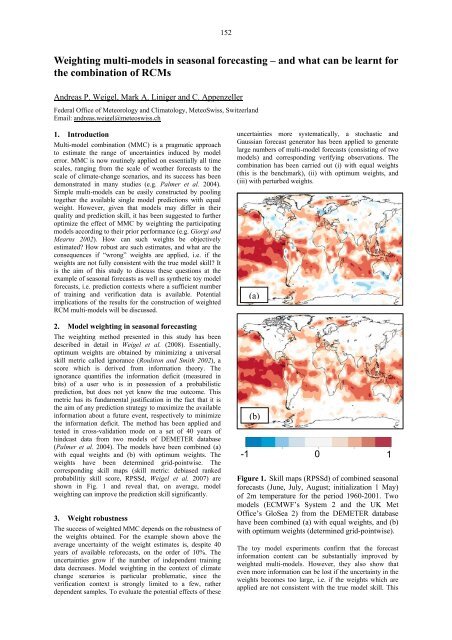Low (web) Quality - BALTEX
Low (web) Quality - BALTEX
Low (web) Quality - BALTEX
You also want an ePaper? Increase the reach of your titles
YUMPU automatically turns print PDFs into web optimized ePapers that Google loves.
152<br />
Weighting multi-models in seasonal forecasting – and what can be learnt for<br />
the combination of RCMs<br />
Andreas P. Weigel, Mark A. Liniger and C. Appenzeller<br />
Federal Office of Meteorology and Climatology, MeteoSwiss, Switzerland<br />
Email: andreas.weigel@meteoswiss.ch<br />
1. Introduction<br />
Multi-model combination (MMC) is a pragmatic approach<br />
to estimate the range of uncertainties induced by model<br />
error. MMC is now routinely applied on essentially all time<br />
scales, ranging from the scale of weather forecasts to the<br />
scale of climate-change scenarios, and its success has been<br />
demonstrated in many studies (e.g. Palmer et al. 2004).<br />
Simple multi-models can be easily constructed by pooling<br />
together the available single model predictions with equal<br />
weight. However, given that models may differ in their<br />
quality and prediction skill, it has been suggested to further<br />
optimize the effect of MMC by weighting the participating<br />
models according to their prior performance (e.g. Giorgi and<br />
Mearns 2002). How can such weights be objectively<br />
estimated? How robust are such estimates, and what are the<br />
consequences if “wrong” weights are applied, i.e. if the<br />
weights are not fully consistent with the true model skill? It<br />
is the aim of this study to discuss these questions at the<br />
example of seasonal forecasts as well as synthetic toy model<br />
forecasts, i.e. prediction contexts where a sufficient number<br />
of training and verification data is available. Potential<br />
implications of the results for the construction of weighted<br />
RCM multi-models will be discussed.<br />
2. Model weighting in seasonal forecasting<br />
The weighting method presented in this study has been<br />
described in detail in Weigel et al. (2008). Essentially,<br />
optimum weights are obtained by minimizing a universal<br />
skill metric called ignorance (Roulston and Smith 2002), a<br />
score which is derived from information theory. The<br />
ignorance quantifies the information deficit (measured in<br />
bits) of a user who is in possession of a probabilistic<br />
prediction, but does not yet know the true outcome. This<br />
metric has its fundamental justification in the fact that it is<br />
the aim of any prediction strategy to maximize the available<br />
information about a future event, respectively to minimize<br />
the information deficit. The method has been applied and<br />
tested in cross-validation mode on a set of 40 years of<br />
hindcast data from two models of DEMETER database<br />
(Palmer et al. 2004). The models have been combined (a)<br />
with equal weights and (b) with optimum weights. The<br />
weights have been determined grid-pointwise. The<br />
corresponding skill maps (skill metric: debiased ranked<br />
probabilitiy skill score, RPSSd, Weigel et al. 2007) are<br />
shown in Fig. 1 and reveal that, on average, model<br />
weighting can improve the prediction skill significantly.<br />
3. Weight robustness<br />
The success of weighted MMC depends on the robustness of<br />
the weights obtained. For the example shown above the<br />
average uncertainty of the weight estimates is, despite 40<br />
years of available reforecasts, on the order of 10%. The<br />
uncertainties grow if the number of independent training<br />
data decreases. Model weighting in the context of climate<br />
change scenarios is particular problematic, since the<br />
verification context is strongly limited to a few, rather<br />
dependent samples. To evaluate the potential effects of these<br />
uncertainties more systematically, a stochastic and<br />
Gaussian forecast generator has been applied to generate<br />
large numbers of multi-model forecasts (consisting of two<br />
models) and corresponding verifying observations. The<br />
combination has been carried out (i) with equal weights<br />
(this is the benchmark), (ii) with optimum weights, and<br />
(iii) with perturbed weights.<br />
(a)<br />
(b)<br />
-1 0<br />
Figure 1. Skill maps (RPSSd) of combined seasonal<br />
forecasts (June, July, August; initialization 1 May)<br />
of 2m temperature for the period 1960-2001. Two<br />
models (ECMWF’s System 2 and the UK Met<br />
Office’s GloSea 2) from the DEMETER database<br />
have been combined (a) with equal weights, and (b)<br />
with optimum weights (determined grid-pointwise).<br />
The toy model experiments confirm that the forecast<br />
information content can be substantially improved by<br />
weighted multi-models. However, they also show that<br />
even more information can be lost if the uncertainty in the<br />
weights becomes too large, i.e. if the weights which are<br />
applied are not consistent with the true model skill. This<br />
1













